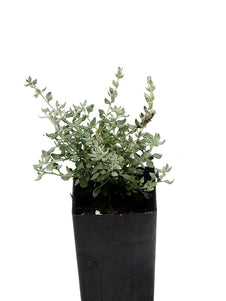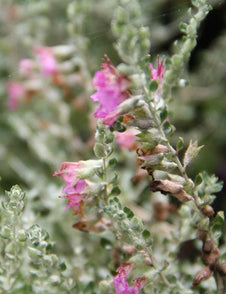



Cat Thyme
Cat Thyme

- In stock, ready to ship
- Inventory on the way

Usually available: All year
Life cycle: Perennial
Height: 30cm
Position: Full sun
Soil preference: Well drained
This is how we pack and send your Herb Plants to all states except TAS & WA
You will receive
- 1 Cat Thyme Herb Plant in a 50 X 75mm tube - General growing instructions
All of our Herb Plants are grown organically with certified organic potting mixes and fertilizers
Botanical Name: Teucrium marum
Cat Thyme is an evergreen and compact, low growing shrub reaching 30cm high by 30cm wide. There are reports that this plant gets larger in ideal conditions. The silver-blue grey leaves are pungent and release a musty scent when brushed against. Leaf shape is lanceolate, broad at the base and downy underneath. The tiny hairs help protect the plant in hot conditions and give the plant an attractive silver sheen. The appearance of this plant is very suggestive of the thyme herb.
Cat Thyme has small pink blooms and flowers from late summer, through December to April in Australia. The two lipped flowers are one sided spikes that may sometimes be a deeper crimson colour. It is self fertile and pollinated by bees and insects. Most people grow it for the ornamental silvery leaves and pink flowers. The plant has a bitter taste and gives off a sensation of heat, which some to describe as a peppery taste. There is a history of medicinal use, however, there does not seem to be a culinary application for cat thyme.
The botanical name seems likely to have been derived from Teucer, the first King of Troy, who was a pioneer in using this plant for medicinal purposes. The word ‘amarum’ is Latin for ‘with bitterness’ and may have contributed to the species name ‘marum’. Cat Thyme (Teucruim marum) is more closely related to the Germanders and Wood Sage or Woodland Germander (Teucrium sp) than any of the thyme herbs. Alternative names for Cat Thyme may include Marum, Amaru, or Mediterranean Germander. This genus is native to Spain and the western Mediterranean but has been distrubted throughout the world. Cats do appreciate cat thyme, although it is unrelated to the catnips/catmints.
Growing Conditions
Cat Thyme prefers full sun and will not grow in shade. Dry or moist soil is acceptable, but the soil must be well drained when there is water available. This plant works well in rock gardens, tolerating heat and drought conditions. A wide pH range and all types of soil are suitable, but heavy salt content in the soil is not tolerated. As a hardy, compact plant, Cat Thyme is able to survive in windy spots. Some reports suggest this herb is not frost tender, but others indicate that it may die down over a very severe and cold winter. To propagate, seed should be sown in spring or alternatively, take semi-hardwood cuttings and divide plants in spring. This plant is low maintenance but may be trimmed after flowering for a tidy appearance and to stop the plant getting too woody.
Medicinal Uses
Cat Thyme has a history of medicinal use and it was considered quite a useful plant for a number of conditions. Herbalists commonly use this plant as a general tonic, stimulant and as an astringent. More specifically it is considered useful for treating threadworm, digestive disorders and as a diuretic. The plant is said to be good for most nervous conditions and helpful for insomnia. It may be used as a tea infusion taken after meals. The root bark is astringent and is used to stop bleeding wounds. A homeopathic remedy made from the whole plant is frequently used for cold treatments and chronic nasal discharge (a runny nose!).
Current research has identified several volatile essential oils that may have further application. The main chemical constituents of the oil are caryophyllene oxide, beta caryophyllene and alpha bergamotene. There are several others in smaller percentages. The volatile oils in the leaves may cause people to sneeze when the leaves are bruised from touch. In its powdered form, the dried leaves were taken as snuff and considered good for ‘disorders of the head’.
Other Uses
Although cat thyme is named for its effect on cats, the catnips and catmints are really more effective if you are planting for your feline friends. Some cats will be attracted to cat thyme and tear it up as they are affected by the chemicals released by the bruised leaves. However, some cats may avoid the plant due to the aroma.
All information provided on this website is for informational purposes only. Please seek professional advice before commencing any treatment.





